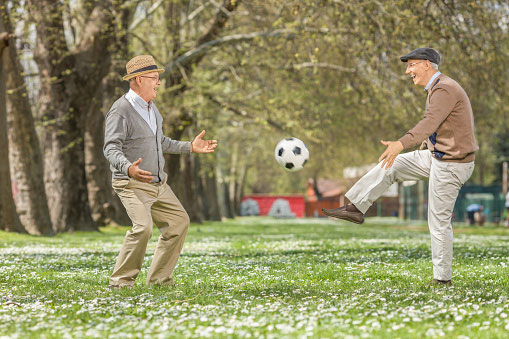
Gerovital-H3®; the world’s first antiaging supplement is now 60-years old!
November 29th, 2016Gerovital-H3®; the world’s first antiaging supplement is now 60-years old!
By Mircea Dumitru, M.D., Ph.D.
Today, Ana Aslan is remembered for her essential contribution to gerontological research as well as for having created a geriatric treatment to influence the aging process, specifically Gerovital-H3®. Ana Aslan was the first person to rule out the fatalistic approach to aging, providing a new method in gerontology by opening the way to the prevention and treatment of old age.
I worked with Professor Ana Aslan for 25 years, from 1963, first as a researcher, then as chief physician and afterwards as the Director of the National Institute of Gerontology and Geriatrics in Bucharest, Romania, between 1978 and 1990.
In the last 3 years of her life, Aslan chose me as her personal physician and three months before her death she asked me to do some personal things, including to write a book about her life and her work. So I took notes at her bedside as a moral testament.
Ana Aslan’s life can be seen in her work. She battled courageously, all for the service of good, to make man’s dream to live with dignity for as long as possible. For 35 years she led the first Institute of Gerontology in the world, she was an Ambassador of Gerontology and a brilliant woman.
I asked her many questions on the terrace of her apartment, she talked of the 84 countries she had visited, the people, their cultures, the famous personalities she’d met, and then often, about the history of her only son- Gerovital-H3® – the product that could improve the quality of life.
I remember her saying; “to grow old in a beautiful and dignified way is at the same time a science and an art.”
When I asked Aslan; “what is aging and old age and how do we fight it?” she answered; “old age is full of suffering and pain and I regard this as a parasite of life which develops slowly and whether you know it or not, it takes hold of us. From the age of 50 onward, I declared war on aging and old age. We have enough possibilities to slow down the aging process and to delay old age onset. We are obliged to guard against it and to explain to healthy or sick patients, what it means to grow old, and what they have to do in order to extend their life in conditions of quality. My treatment and my method is a solution, Gerovital-H3 is not only a treatment, it is hope.”
The biological basis of Gerovital-H3® treatment
Ana Aslan stopped using ‘plain’ hydrochloric procaine since her research results materialised a different product with a new formula that was named Gerovital-H3®. In the new formula, the addition of benzoic acid to the procaine induced a greater access of the procaine into the hydrophobic cellular compartments and modified the pharmacological action of it. It should be noted that between Gerovital-H3® and hydrochloric procaine there is a difference of pharmacological action. For example, procaine by itself has a stability of 6-months, whereas the Aslan product has a much increased stability of two and half years.
Once introduced into the human body, the procaine molecule is hydrolysed into two metabolical fractions; specifically paraaminobenzic acid (PABA) and diethylaminoethanol (DEAE); however the absorption of the two metabolites is better when they result from the in-vivo hydrolysis of Gerovital-H3® than when they are administered separately. The procaine from Gerovital-H3® has a greater capacity of wadding the medium (pH), due to benzoic acid, reducing the degradation speed of the product. Interestingly, in the case of Gerovital-H3®, the chromatographic techniques showed that there are intact procaine molecules in the blood and heart of experimental animals 6 hours after the product is administered.
It is considered that procaine is metabolised differently depending on the pH of the solution. At a pH of 7, the procaine is permeated ‘en mass’ into the blood, but at a pH of 3.3 the procaine is gradually set free from the blood. An acid solution will decrease the sudden release of the substance, a quality that Gerovital-H3® possesses. (1, 2, 3) Therefore, Gerovital-H3® acts upon the human body both under the form of an intact molecule and through the hydrolysis products PABA and DEAE, which participate in the regulation of the intermediary metabolism.
Gerovital-H3® favors the acetylcholine synthesis and it is a source of folic acid. Research suggests that procaine, by means of PABA, stimulates the intestinal flora and the production of folic acid, vitamin K and tyramine. Pharmacological studies (4) summarise its basic mechanisms as:
- Gerovital-H3® competitively and reversibly inhibits monoamine oxidase (MAO).
- Gerovital-H3® acts as an anti-depressive through the modification of the MAO level in the brain.
- Gerovital-H3® is considered to play a role in maintaining the physiological status of the nervous cell membrane, restoring the equilibrium between the processes of excitation and inhibition at the level of the cortical and subcortical systems.
- Gerovital-H3® exerts an important regulatory action upon the nervous vegetative centers.
- Further experiments reveal procaine’s anabolic action.
- Studies on Infusoria (Colpidium colpoda and Vorticella) show the proliferation of cells (6).
The investigations on animals drew the attention of procaine’s anabolic affects especially improving the quality of the hair (7, 9).
Gerovital-H3’s® action upon the lipid mechanism is reflected through several mechanisms:
- Gerovital-H3® diminishes the level of plasmatic lipoproteins and lipids.
- Gerovital-H3® exerts an effect on the erythrocyte membrane.
- Gerovital-H3® has an anti-oxidant mechanism that reduces the oxidative stress exerted on the membrane structure.
It has been shown that Gerovital-H3® action on the lipid metabolism results in positive modifications in improving the serum total of cholesterol, changes to the lipoprotein fractions ratio and also changes to the unsaturated fatty acids content (11).
The international confirmations
Mention must be made of the fact that the research concerning Gerovital-H3® therapy has been simulated in more than 500 medical and scientific publications. The experiments that utilized the original Aslan product and method confirm the efficiency and efficacy of Gerovital-H3®.
Special interest was generated by the mechanism of Gerovital-H3®’s action by several American scientists who presented papers of double-blind placebo controlled trials. Among them was Professor William Zung from Duke University, North Carolina who in his study applied the treatment for 28 days on his patients who were suffering from depression (12). One group of patients aged 60 were submitted before, during and after the treatment to a battery of psychological tests. Professor Zung proved the Gerovital-H3 ® efficiency in the treatment of depression.
Furthermore, the American authors, M. Kurland and M. Hayman from Palm Springs, California, presented the double-blind results performed with Gerovital-H3® on 63 patients suffering from depression aged 45 to 80 (33 using Gerovital-H3® and 30 using placebo). Under observation there were several types of depression; manic-depression, reactive depression, organic cerebral depression, chronic reactive depression and alcoholic depression. The results proved that Gerovital-H3® efficiency in all the tests applied, the differences between the two groups showed a great statistical significance.
Recognition has come from the world-wide known gerontologist, Alex Comfort of England, who in an article published in the magazine ‘Mechanism of Ageing and Development’, made positive remarks upon Gerovital-H3® and Aslan’s method and on the occasion of the international meeting ‘Medizinischewoche’ in Baden Baden, Germany, whilst concluding the Gerontology and Geriatrics section, Professor Paul Luth said; “The Aslan treatment method represent a most efficient therapeutic procedure in geriatrics.” (15)
Aslan’s method of prophylactic and curative treatment with Gerovital-H3®
Ana Aslan declared of Gerovital-H3®; “After one injection in the femoral artery given to a patient with embolism at the level of the inferior extremity, I noticed the almost instantaneous disappearance of pain. Then, for the first time, I had the idea of applying the same method in certain diseases with acute pain, which produce immobilization and thus long-lasting work incapacity.”
Like other great discoveries, the clinical observation facts did not fail Aslan, as they represented the beginning of a period of original and fundamental studies which contributed to the prophylaxis and treatment of aging and chronic disease. Thus, in that period, another clinical observation was pointed out by the patients who stated that after the injections, (given into the artery of the extremities) pain was relieved in all the body.
Injectable Gerovital-H3® was first experimented with at the Institute of Gerontology and Geriatrics in Bucharest in 1953 and then in 1957 Aslan started comparative investigations to establish the effectiveness of the oral treatment. It was found that in order to achieve the same results like in the parental treatment, the oral dose had to be doubled.
Indications for Gerovital-H3®
Gerovital-H3® is indicated for people older than 40 years in order to retard the aging process and as a preventative and curative treatment for chronic degenerative diseases. Gerovital-H3® has been shown to be efficacious in all the following:
- Moderate and light depressive states.
- In troubles concerning attention, concentration and cognitive processes.
- Chronic fatigue syndrome.
- Sleep disorders.
- Tegument dystrophies, trophic ulcers, atonic wounds.
- Osteoarthritis, degenerating rheumatism, osteoporosis and during fracture consolidation periods.
- Sexual management and improving sex drive.
- Gerovital-H3® is an active anti-aterogenous factor and recommended in cerebral and peripheral arthrosclerosis.
- Parkinson’s disease and Parkinsonian syndromes.
- Gerovital-H3® ameliorates the hair quality, its repigmentation and reduces alopecia (hair loss) and head skin seborrhoea (dandruff).
- Due to the inhibition on the generation of the superoxide radical, Gerovital-H3® is also a powerful antioxidant.
Outcome of Gerovital-H3 ® treatment
Aslan’s treatment produces a general transformation of the organism manifested as follows;
- Desires to be active, have better memory, enhanced concentration and improved optimism.
- Greater affective tone and psychic and vegetative balance.
- Increased self-caring abilities and exercise capacity.
- More ability to cope with the environment and increased resistance to infections.
- Better balanced endocrine functions with estrogens reappearance and androgen reactivation.
- Improved visual, audio and smell acuity.
- Diminished extrapyramidal rigidity, improved gait and increased mobility.
- Better skin, nails and mucous.
- Hair growth stimulation with a tendency to repigmentate the hair and a more trophic aspect.
- Better blood vessel reactivity.
- Alleviation of the clinical symptoms of chronic diseases such as rheumatism, atherosclerosis, bronchial asthma, psoriasis, vitiligo and varicose ulcers.
- Improves the quality of life retarding the rhythm of aging and preventing the chronic diseases.
- Improved sex drive.
Administering method for Gerovital-H3®
The long term treatment with Gerovital-H3 ® has been extensively established by Aslan. In the beginning, Gerovital-H3 ® was administered only as injections. The tolerance has always been tested before starting the treatment; one subcutaneous injection of 1 ml on the first day, followed by an intramuscular injection of 2 ml the next day.
If no local or general reactions occur, proper treatment can be started. In the experience of more than 300,000 patients that completed this treatment in Romania, intolerance only occurred in 1 in 7000 cases.
Preventative treatment
Treatment of chronic diseases and aging consists of 4 courses of 12 injections and 4 courses of 24 pills, i.e., one course of 12 injections over 4 weeks (i.e., 3 injections per week), a 4-week break then one course of 24 pills over 12 days (one pill twice daily between meals), a 2-week break and then the cycle is resumed.
Starting from the age of 40 years, the prophylactic treatment with pills only is recommended in a series of 25 tablets during the first 12 days, with an interval of 2 months; 1st day, 1 tablet/ day, 2-hours after breakfast, increasing to the 12th day when 2 tablets per day are taken, (again 2-hours after meals, for example one at 10 AM and another at 4 PM). There should a series of 5 treatment courses in the year, which should be increased to 6 per year for persons over the age of 65.
Curative treatment
Chronic diseases require a 6 course of 12 injections, and 5 courses of 24 pills, yearly, i.e., one course of 12 injections over 4 weeks, a 2-week break, one course of 24 pills over 12 days (one pill twice daily between the meals); 2 week break. The cycle is then resumed.
Depending upon the outcomes the physician and patients can either shorten or extend the breaks. The first and second course of injections can be administered daily in order to study the individual reactivity.
Gerovital-H3® treatment can be individualised according to the disease/ diseases accompanying the aging and the patient’s biological age.
Contraindications
Gerovital-H3® should be avoided by anyone suffering or utilising the following;
- Allergy or sensitivity to Gerovital-H3® (or Novocaine).
- Gerovital-H3® cannot be used together with eserine or prostigmine.
- Gerovital-H3® cannot be used at the same time as sulphamides.
- Gerovital-H3® should not be used with an antibacterial treatment.
Side effects
Gerovital-H3® side effects are uncommon. With injections minor side effects consist of a heating sensation and metallic taste; these effects disappear during the treatment. Other side effects are related to the skin; macular eruption, rash and itching which determine the interruption of the treatment and the remake of the tolerance test (1 ml injected id.) after the eruption has disappeared.
In spite of its monoamine oxidase (MAO) inhibitor character, Gerovital-H3® does not interfere, as the conventional MAO inhibitors do, with the tyramine from food (commonly called the cheese affect), which means there is no known incompatibility with Gerovital-H3® and food.
References
- Cohen S., Ditman K.S. Effects of Gerovital-H3® on Elderly Depressive Patients. Int. Symposium of Gerontology, Bucharest, 1972.
- Teitel A., Gane P., Stroescu V., Steflea D., About the Mechanisms of Procaine. Studies of Fisiology, Bucharest, 1962, 4, 351-360.
- Gordon P., Fudema A., Abrams A., Effects of Romanian and American Procaine Preparations on Certain Physiological Aspects of Aging. Gerontologist II, 1962, p.9, Gerontologist, 1965, 20, 2, p114-150.
- Ana Aslan; Gerovital-H3 ® Therapy in the Prophylaxis of Ageing. Rom. J. Geront. Geriatrics. Bucharest, 1980, 1,1 p5-15.
- Yau M.T. Gerovital-H3 ®, Monoamine oxidase and Brain Monoamines. Symposium on Theoretic Aspects of Aging, 1974, Miami, Florida.
- Parhon C.I., Ana Aslan, L’action de la Vitamine H1 et H2 sur la proliferation de la cellule animale. Bull. Acad. Rom. Bucharest, 1957, 9, 1, 137.
- Berger P; Innocuite du traitment chronique a la procaine chez le rat en croissance. C.R. So. Biol. 1960, 154,959.
- Verzar F. Note on the influence of procaine, PABA and DEAE on the aging of rats. Basel, 1959, Gerontology 3, 6, 350-355.
- Ana Aslan et col. Long term treatment with Gerovital-H3® in Albino rats. J. Gerontology, 1965, 20, 1.
- Ana Aslan, G. Enachescu. Researches on the Anti-thrombophilic activity of Gerovital-H3® treatment. Rom. J. Geront. Geriatrics, 180, 1, 2, 195-246.
- Russu C et col. Antioxidant and lipid lowering effect of original procaine based product Gerovital-H3®. Book of abstracts. The 16th Congress of the International Association of Gerontology, p217.
- Zung W.W.K., Wang H.S. Clinical trials of Gerovital-H3® in the treatment of depression in the elderly. 10th Int. Congress of Gerontology, 1975, Jerusalem.
- McFarlane MD Gerovital-H3® therapy; Mechanism of inhibition of monoamine oxidase. J. of American Geriatrics Society., 1974, XXII/8, p365-371.
- Robinson D.S. et al; Aging, monoamine and monoamine oxidase levels, 1972, Lancet, 1, 0290.
- Luth P. Aslan therapie mit Gerovital-H3 ®. Zeitschrift fur Algemenmedizin, 1984, 60, 27, p1162-1164.






